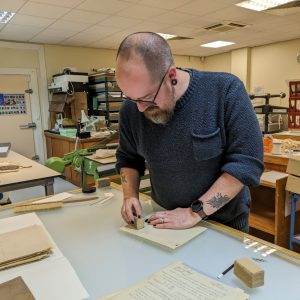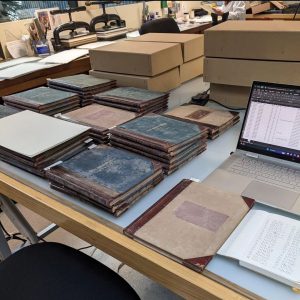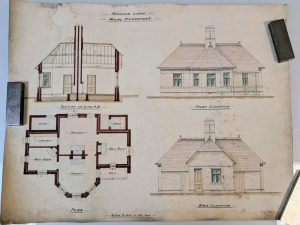November 21, 2023, by Kathryn Summerwill
Cataloguing History: Time with the Manvers Collection
This is a guest post by Andy Judson, a student volunteer studying towards a PhD in History at University of Nottingham. He recently completed a 60-day placement funded by the Midlands4Cities Doctoral Training Partership and the Arts and Humanities Research Council (AHRC). The placement engaged him to work with part of the extensive Manvers Collection, relating largely to the family’s estate at Holme Pierrepont, Cotgrave, Radcliffe-on-Trent and Sneinton, under the supervision of archivist Kathryn Summerwill and conservator Robert Pearce.
First Steps
The first couple of weeks were spent getting to grips with the contents of this part of the collection, which had been isolated following fumigation in the 1990s. The documents were contained in some 51 boxes, comprising account and rental books, rolled plans and maps, and a dizzying number of correspondence documents (over 9,000 individual letters!). The initial task was to go through box by box to confirm that the contents were as expected. As my time was to be split between cataloguing and conservation, a solid but flexible plan of action was required.
Cleaning and Preparation
As the majority of the documents were filthy, and unsafe for handling, the first priority was cleaning. Depending on the type of document, there are several different methods to use. The rental books were cleaned over a Bassaire workstation, using a large soft brush to remove particulates such as mould spores and insect droppings from the cover and inner pages. Individual pages were then cleaned using a ‘smoke sponge’, which picked up more stubborn elements. Letters and plans were also cleaned using these sponges, although the rolled plans needed to be humidified and flattened in a large screw press beforehand. The letters, which had been loosely bundled together in 6-month periods, also needed flattening to remove creases and minimise the chance of further damage, but this was done by hand. The final stage of this ongoing process was repackaging. The books were measured ready to be housed in bespoke individual boxes, whilst the majority of the other documents were individually numbered (in pencil, of course!) and wrapped in special acid-free paper.
Cataloguing Challenges
Once there was a good buffer of cleaned documents, I could start the process of cataloguing in earnest. The first, and simplest, task was to identify and chronologically order the rental books. A much more involved task was cataloguing the correspondence bundles. Due to time constraints, it was not practical or desirable to catalogue each letter individually. Each of the original 6-month bundles is now catalogued with a summary of its contents, including significant people, places, and subjects. Finally, the maps and plans were catalogued individually (there were significantly fewer maps than letters) and organised by location. All of this information was entered into Excel spreadsheets for transfer to the Manuscripts Online Catalogue by the archivist.
Reflections
Overall, this has been a thoroughly enjoyable and satisfying experience. One thing I noticed was that I didn’t expect to be drawn in by the correspondence as much as I have been. Letters received express condolence for the death of R.W. Wordsworth, the Thoresby estate agent, and later the death of Earl Manvers, and the subsequent division and dismantling of the Holme Pierrepont estate can be witnessed in what feels like real time. The correspondence covers the First World War, and there are letters from tenants worried they will be unable to manage with sons called up, offering up part of the estate for convalescence, and among the others, a simple request for a small playground of swings and benches on Carlton Road, opposite a building which housed Belgian refugee families.
I would absolutely recommend applying to volunteer in your local archive if you have the opportunity. I have gained valuable experience and skills, and in a small way helped preserve part of Nottingham’s heritage for future generations.
Further information
The catalogue for the Estate Papers of the Pierrepont Family, Earls Manvers, of Thoresby Hall, Nottinghamshire, and their successors, in the Manvers Collection, largely relating to the Holme Pierrepont estate (1885-1961), can be accessed via the Manuscripts Online Catalogue (Document Reference Ma 11).
Rentals, correspondence and plans from this collection can be accessed in our Reading Room – to find out more, or to book an appointment today, please contact us at mss-library@nottingham.ac.uk.
No comments yet, fill out a comment to be the first




Leave a Reply